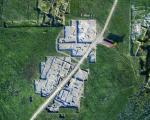Summary (English)
KABYLE (Stefan Bakardzhiev – st_bakarjiev@abv.bg) The excavations of Building F continued. It was situated to the north of peristyle Building D and to the east of the partly excavated cardo. Three construction periods were documented in Building F. The first one dated to AD 150 – 250. The walls were built of bricks bonded with mortar and were 1.05 m, 85 cm and 70 cm wide. The finds included a fragment from a bronze statue, a fragment from a bronze head of an eagle, bronze and silver coins minted from Antoninus Pius to Severus Alexander, a Latin inscription indicating the construction of thermae during the reign of Marcus Aurelius that was reused in the floor of the second construction period. The second construction period dated to AD 250 – 275 when Gothic invasions occurred and in the following decades. The walls were built of roughly-cut stones bonded with mortar and were 55 – 60 cm wide, preserved up to 50 cm in height. Their upper parts were constructed of sun-dried bricks. Coins minted from Claudius Gothicus to Diocletian were found. The building was probably destroyed in AD 377/378 when the Goths sacked Kabyle. The third construction period dated to the reign of Justinian I. The walls were built in rubble masonry. Parts of the rooms were reused, while the building already lost its initial purposes. An impluvium, 50 cm deep and 7 m by 4.25 m in size, was discovered in the center of the atrium of Building D. Its bottom was paved with bricks, plastered with hydraulic mortar. During the construction of the impluvium, part of an eschara and a floor of a Hellenistic building were destroyed, dated by a coin of Antiochus II Theos countermarked by Kabyle. Two layers with traces from fire were documented beneath, the lower one containing a coin of Abdera minted in mid 4th century BC, related to the military campaigns of Philip of Macedon in Thrace when the Macedonian army conquered Kabyle.
- Stefan Bakardzhiev - Museum of History - Yambol
Director
- Stefan Bakardzhiev - Museum of History - Yambol
Team
Research Body
- Museum of History - Yambol






![Download [PDF]](/excavation/skins/fasti/images/results/download_sml.png)
